Tamilnadu State Board New Syllabus Samacheer Kalvi 7th English Guide Pdf Term 2 Prose Chapter 2 The Last Stone Carver Text Book Back Questions and Answers, Summary, Notes.
Tamilnadu Samacheer Kalvi 7th English Solutions Term 2 Prose Chapter 2 The Last Stone Carver
7th English Guide The Last Stone Carver Text Book Back Questions and Answers
Warm Up (Text Book Page No. 113)
Work in pairs.
Read the instructions given below, draw and name the picture.
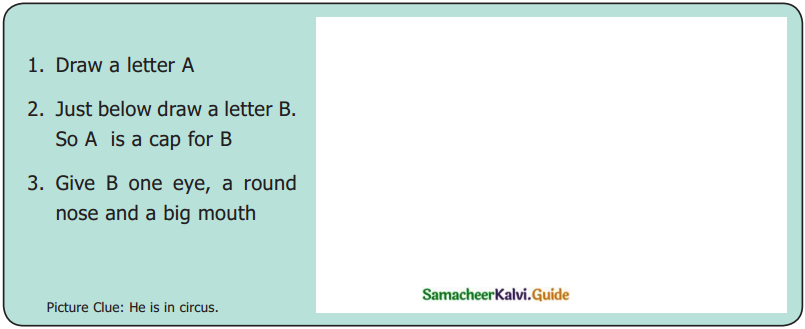

Write step by step instructions for the following picture.
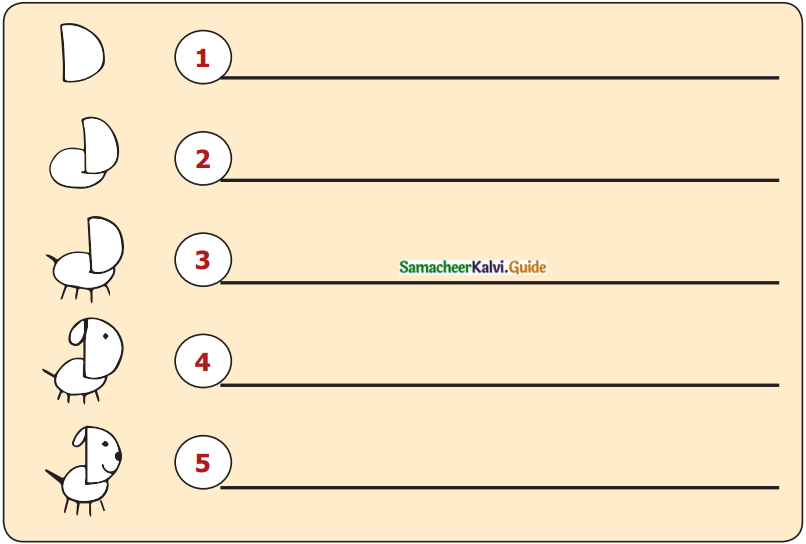
1. Draw the letter ‘D’.
2. Draw an elliptical circle at the bottom portion of ‘D’.
3. Draw five straight lines at the elliptical circle.
4. Have a dot as eye in the letter ‘D’
5. Draw an elliptical small ear and a big black dot for the mouth in the letter ‘D’.
Section – I
Textual Exercise (Text Book Page No. 116)
Which of the two sentences given below convey the following meaning?
1. stained by – mark made on clothes or materials
The whitewashed walls were stained by many monsoons …………………………
a) The walls were made dirty by rains.
b) The Monsoon removed the dirt from the walls.
Answer:
a) The walls were made dirty by rains.
![]()
2. working for a pittance – working for very little money
I am tired of working for a pittance.
a) He didn’t want to work because he was tired.
b) He didn’t want to work as he gets low income for his work.
Answer:
b) He didn’t want to work as he gets low income for his work.
3. ashen – pale
His face was ashen.
a) He looked pale and dull.
b) He looked bright and cheerful.
Answer:
a) He looked pale and dull.
4. drenched – thoroughly wet
He is drenched to the skin.
a) He is thin and skinny.
b) He is thoroughly wet.
Answer:
b) He is thoroughly wet.
Section – II
Textual Exercise (Text Book Page No. 118)
Read the sentences and number them in the correct order.
| 1. The old man worked tirelessly on the sculpture. | 1 |
| 2. He had a strong wish to finish it in time. | 2 |
| 3. Over days, he felt very weak. | 3 |
| 4. He thought he wouldn’t be able to finish it. | 4 |
| 5. He wished to have Gopal with him. | 5 |
| 6. He realized that Gopal must learn to carve the finer details. | 6 |
| 7. Salim felt that it should come from within. | 7 |
Section – III
Textual Exercise (Text Book Page No. 120)
Read Section – III (para 1 and 4) and answer the following questions.
Paragraph 1
1. Who listened to the chipping sound of the chisel?
Answer:
The old man listened to the chipping sound of the chisel.
![]()
2. Who was working with the hammer and chisel?
Answer:
Salim was working with the hammer and chisel.
Paragraph 4
1. Who was staring?
Answer:
The old stone carver was staring at the back of Salim who was working on the statue.
2. Who was the young stone carver?
Answer:
Salim, the servant boy was the young stone carver.
3. What was he working on?
Answer:
Salim, the servant was working on the statue of Lord Krishna.
Vocabulary (Text Book Page No. 121)
Work in pairs.
A. Arrange the words in alphabetical order, find the meaning of the words from the dictionary and fill in the blanks.
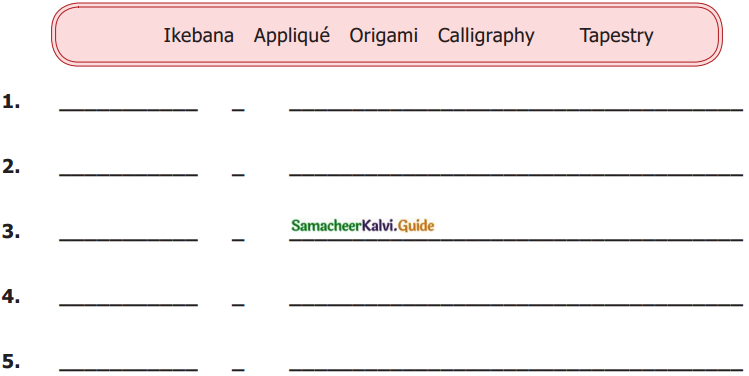
1. Applique – embroidery work
2. Calligraphy – beautiful handwriting
3. Ikebana – Japanese flower arrangement
4. Origami – Japanese paper art
5. Tapestry – cloth with designs and pictures
B. Match the tools with art forms.
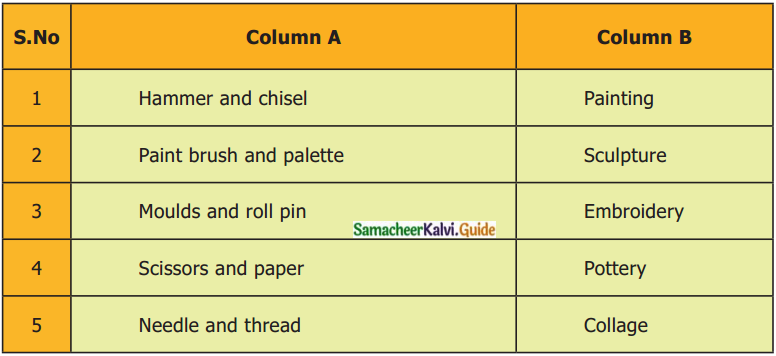
Answer:
| Column A | Column B |
| 1. Hammer and chisel | Sculpture |
| 2. Paintbrush and palette | Painting |
| 3. Moulds and roll pin | Pottery |
| 4. Scissors and paper | Collage |
| 5. Needle and thread | Embroidery |
Listening (Text Book Page No. 122)
C. Listen to the teacher reading the passage. Read the questions given below, then listen to passage again and complete the responses. (Text for listening is in page no -136)
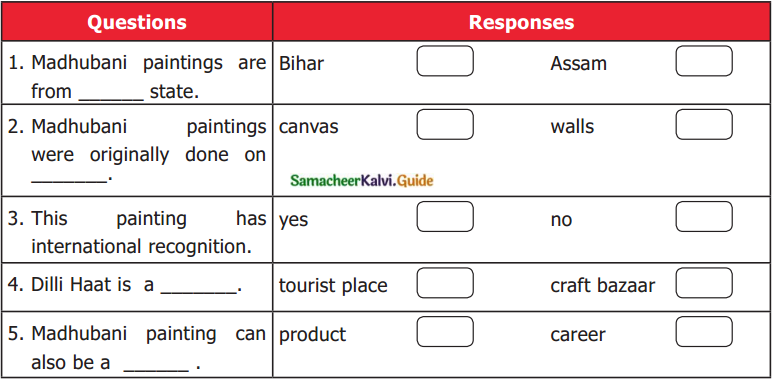
Answer:

Speaking (Text Book Page No. 122)
D. Work in pairs. Find answers to these questions and present it to the class.
Do you have an art/craft session at your school?
Answer:
Yes, we do have art and craft session in our school.
Which session do you like – art/craft?
Answer:
I like craftwork sessions.
![]()
What do you do in that session?
Answer:
We make a lot of new models.
Do you work individually or in pairs?
Answer:
We work in pairs as well as individually.
Can you do artwork or craftwork on your own?
Answer:
I can do a craft on my down. I can do a model of a house.
What qualities do you gain by doing art or craft?
Answer:
Good habits are formed. We can spend our recreation time and holidays doing art and craftwork.
Use Grammar
E. Construct meaningful sentences from the table given below. (Text Book Page No. 124)
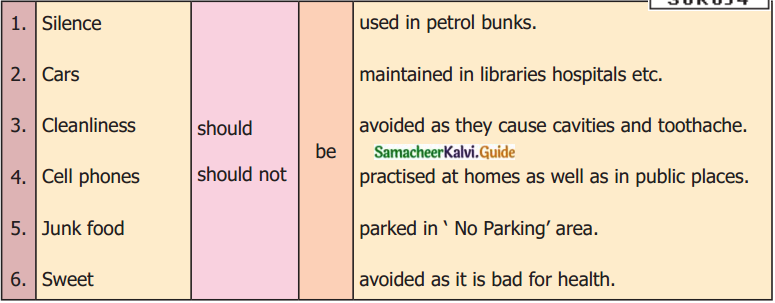
1. Silence should be maintained in libraries, hospitals, etc.
2. Cars should not be parked in the ‘No Parking’ area.
3. Cleanliness should be practised at homes as well as in public places.
4. Cell phones should not be used in petrol bunks.
5. Junk food should be avoided as it is bad for health.
6. Sweets should be avoided as they cause cavities and toothache.
| All the above sentences are in the passive voice. All these sentences have transitive verbs, that is verb + object. For example: 1. We should not use cellphones in petrol bunks. (Active voice) Cell phones should not be used in petrol bunks. (Passive voice)2. We must not park cars in the No Parking area. (Active voice) Cars should not be parked in the No Parking area. (Passive voice) |
F. Read the news report given below and underline the passive form of verbs.
The police had announced that the State Bank of India was robbed yesterday. Two men entered the bank at 4.30 pm with guns in their hands. Customers and bank clerks were asked to lie down on the floor, and one of the bank clerks was made to fill robbers’ bags with money. After that, the two men left the bank quickly. The police officer said that more than one lakh of rupees was stolen from the bank but nobody was injured. He also added that the robbers would be found soon.
Note: The underlined words “was robbed, were asked, was made, were stolen, was injured, would be found” are the passive form of verbs given in this passage. The main verbs “robbed, made, stolen, injured, found” are in the past participle form.
Work in Pair
G. Rani’s teacher narrates to her students about the production of paper. Read the following narration and fill in the blanks with the verbs using their passive form.
People of China produced paper from wood. They mixed water with the fibres of the wood and dried
it until they became a soft wet pulp. They used this pulp to make paper. The Chinese invented this
method of papermaking in the 2nd century BCE. Later Egyptians used papyrus plants to make paper.
1. Paper …………… (produce) from wood.
Answer:
is produced
2. The fibres of wood from trees …………… (mix) with water to make a soft wet pulp.
Answer:
are mixed
![]()
3. Later, it …………… (dry) to make paper.
Answer:
is dried
4. .This method …………… (invent) in 2nd BCE in China.
Answer:
was invented
5. Papyrus plants …………… (use) by Egyptians to make paper.
Answer:
were used
H. Read the process of making soup. Use the suitable passive forms of verbs and complete the paragraph. (Text Book Page No. 125)
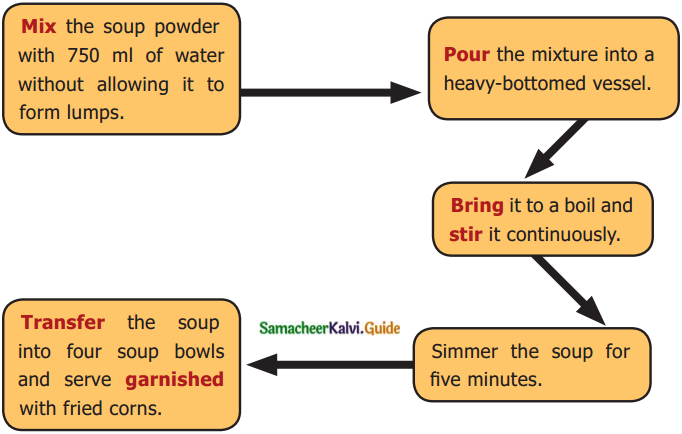
The packet is opened and the contents (i) …………… with 750 ml of water, without allowing it to form lumps. The mixture (ii) …………… into a heavy-bottomed vessel. It (iii) …………… in low flame for five minutes. The soup (iv) …………… into soup bowls and (v) …………… with fried corns.
Answer:
(i) are mixed
(ii) is poured
(iii) is simmered
(iv) is transferred
(v) served
Writing (Text Book Page No. 125)
I. If you are asked to choose from any one of these toys which one do you choose? Give reasons, (plastic toys, wooden toys, clay toys, metallic toys)
Answer:
If I am asked to choose toys I will choose only clay toys. Clay toys are eco-friendly. The price of them is cheap. Clay toys have been used since ancient times.
J. Your friend has presented a beautiful art piece on your birthday. Write a letter to her appreciating her artwork.
| 37, Jansy Road, Madurai -19, 10. 10. 2020. My dear Leela, How are you? I am fine. I am studying well. Your present on my birthday was very special. I like it very much. The painting presented by you on my birthday is admired by everyone. Thanks a lot. Yours lovingly, Address on the envelope |
Creative Writing (Text Book Page No. 125)
K. You have prepared some eco-friendly craft materials like paper mache dolls, greeting cards, bookmarks, festoons, garlands, quilling jewellery, etc for an Art Mela to be conducted on your school premises. Describe in a few sentences how you made the craftwork. Include the following details in your writing.
Name of the craftwork
Answer:
Clay toy
Materials used
Answer:
Clay, salt, water
Nature (handy / eco-friendly, longlasting / affordable price)
Answer:
eco-friendly, affordable price, handy, portable
Use (place / person / time)
Answer:
It can be used by small children as well as adults. It is portable. It can be carried to any place. India has a fine tradition of making clay toys by mixing clay, salt, and water. The mixture must be poured in moulds after kneading to even consistency.
The Last Stone Carver Summary in English
The stone carver, an old man, was deserted by his son, Gopal, in the midst of his sculpting work. It was his biggest and best work. It might be his last work too. The marble statue was only half-finished. After the departure of his son Gopal, the old man felt very sad. An orphan boy named Salim was a servant to the stone carver. Salim comforted his master and provided him refreshment. The old man worked tirelessly to finish the statue of Lord Krishna by himself in time. Soon, he lost his energy and knelt down. He wished to get the help of his son Gopal to finish the statue. He also said that even Gopal had yet to learn some finer details of stone carving. The old man worked hard throughout the night. He fainted down. When he opened his eyes he found himself on a cot. The old stone carver heard the noise of chisel and hammer. He thought that Gopal had returned home. He went out to see. But, Gopal was not there. The young sculptor Salim, the servant was there. The old man was surprised and felt happy. He blessed Salim that he would be one of the country’s finest stone carvers.
The Last Stone Carver Summary in Tamil
வயதான கற்சிற்பி ஒருவரை அவரது மகன், கோபால் பிரிந்து செல்கிறான். சிற்பியின் வேலை பாதிதான் முடிந்துள்ளது. அச்சிற்பம் பெரியது. சிறந்தது. ஒருவேளை சிற்பியின் கடைசி சிற்பமாகவும் இருக்கலாம். சிலை பாதியளவே முடிவடைந்து இருந்தது. சிற்பி வருத்தமடைந்தார். தான் இந்த பெரிய வேலையை எவ்வாறு தனியே செய்யப் போகிறோம் என்று கலக்கமடைந்தார். அவரது வேலைக்காரர் சலீம், ஓர் அனாதை. தன் எஜமானரை அவன் சமாதானப்படுத்தினான். அவருக்கு உணவு அளித்து ஆதரவு தந்தான். ஸ்ரீ கிருஷ்ணனின் சிலையை முடிக்க, சிற்பி மிகப் பாடுபட்டு உழைத்தார். ஆனால் அவரது சக்தி குறைந்து கொண்டே வந்தது. நிற்கக்கூட முடியவில்லை. தன் மகன் கோபால் அவருடன் இருந்தால் நன்றாக இருக்கும் என எண்ணினார். ஆனால் கோபால் சிலை வடிவமைப்பதின் சில நுட்பங்களை இன்னும் நன்றாகக் கற்றுக் கொள்ள வேண்டும் என்று நினைத்தார். இரவு முழுவதும் உழைத்ததால் மயங்கி விழுந்தார். கண்களை விழித்தபோது ஒரு கட்டிலின் மீது படுத்திருப்பதை உணர்ந்தார். சிற்ப வேலை செய்யப் பயன்படும் சுத்தியின் ஒலியைக் கேட்டார். தன் மகன் கோபால் வீடு திரும்பிவிட்டான் என நினைத்தார். வெளியே சென்று பார்க்கையில் கோபால் அங்கு இல்லை. செதுக்கும் வேலையை சலீம் செய்து கொண்டிருந்தான். கிழவர் வியப்படைந்து மகிழ்ந்தார். சலீமை உலகத்தின் மிகச் சிறந்த சிற்பிகளில் ஒருவராக ஆகப்போகிறாய் என ஆசீர்வதித்தார்.
The Last Stone Carver About the Author in English
Sigrun Srivastav is an Indian author of German origin. She is a multi-faceted artist^ a writer, a sculptor, and an illustrator. As a writer, she has written over 25 books for children of all ages.
The Last Stone Carver About the Author in Tamil
சிக்ரன் ஸ்ரீவத்ஸ்தவ், ஜெர்மன் வம்சாவளியைச் சேர்ந்த இந்திய எழுத்தாளர். பன்முகத் திறமைகள் கொண்ட பெண் இவர். கலைஞர், எழுத்தாளர், சிற்பி, என எதையும் எடுத்து இயம்பும் ஆற்றல் பெற்றவர். பல்வேறு வயது உள்ள குழந்தைகளுக்காக 25 புத்தகத்திற்கு மேல் இவர் எழுதியுள்ளார்.